- Waterhemp identification
- Ontario counties with confirmed resistant populations (Dec 2023)
- Testing services to identify waterhemp and if herbicide resistant
- Waterhemp control in corn
- Waterhemp control in soybean
- Waterhemp control in winter wheat
- Influence of cover crops on waterhemp
- Influence of tillage on waterhemp
- Acknowledgments
Go back to main index
SPECIES INFORMATION
Lifecycle: Annual
Propagation: Reproduces by seed, dioecious, has separate male and female plants.
Emergence: Spring, typically after lamb’s-quarters, emergence continues through late summer or early autumn depending on weather conditions.
Habitat: Not native to Canada. Now found in several counties throughout Ontario in agricultural fields. Historically it was found mainly along waterways and beaches. Prefers full or partial sun, moist or wet conditions.
Competitiveness: In University of Guelph research trials, poor control of waterhemp has resulted in up to 99 percent yield loss in both corn and soybeans.
IDENTIFICATION CLUES
Seedlings
Cotyledons: Linear, narrow, purple-red underneath.
Mature leaves: Lance-shaped (tapered and typically with a pointed tip), with a wavy margin.
Mature Plant
Stem: Alternate leaf orientation; smooth with no hairs; variable colouring (green to red/purple); up to 3.5 m in height.
Seed heads: Long, spikey clusters (somewhat similar to ragweed) that can vary in colour from green to red to purple. Only the female plants produce seed.
Roots: Taproot
OFTEN MISTAKEN FOR
I know it’s NOT … because…
Redroot pigweed … The stem of redroot pigweed is covered in dense short hairs, whereas waterhemp is smooth and hairless. The tips of waterhemp leaves are typically not notched.
Green pigweed … The upper stem of green pigweed has a cluster of dense hairs whereas the stem of waterhemp is smooth and hairless. Waterhemp will typically have narrower leaves with wavy margins and without a notched tip.
Eastern black nightshade … The leaf margins of young eastern black nightshade leaves are hairy and the older leaves have wavy toothed margins whereas waterhemp leaves are hairless with wavy margins.
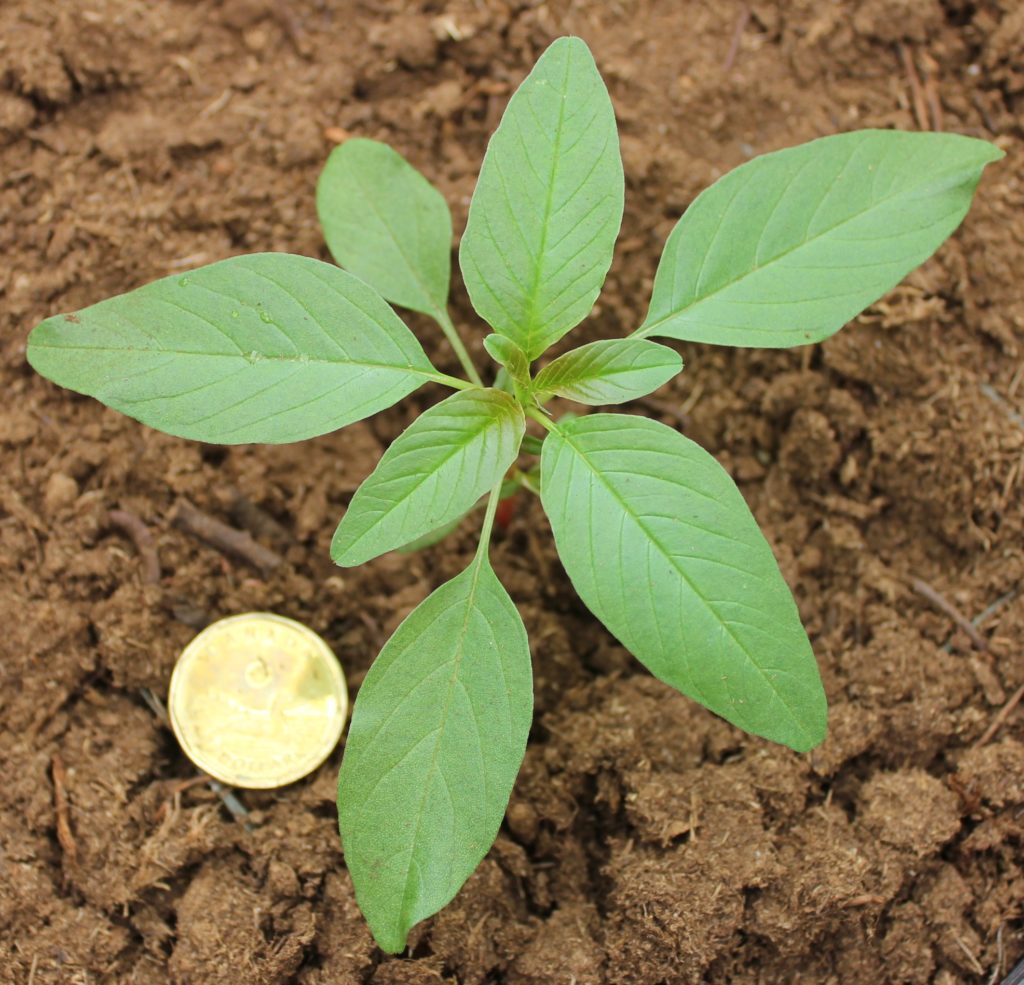
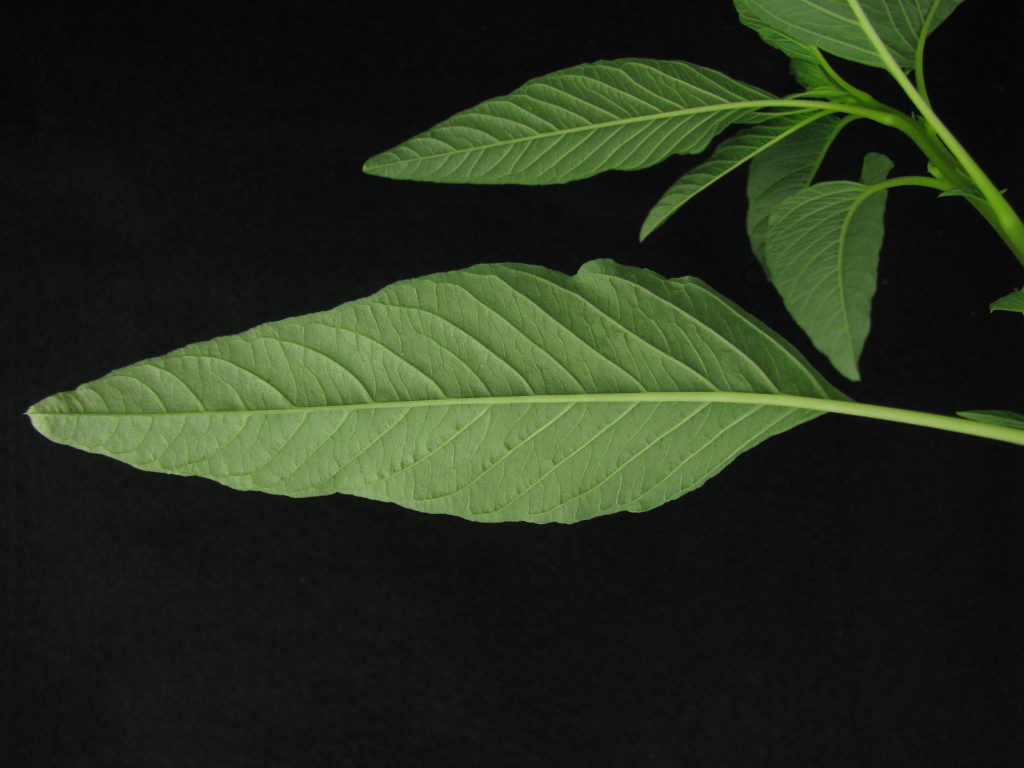
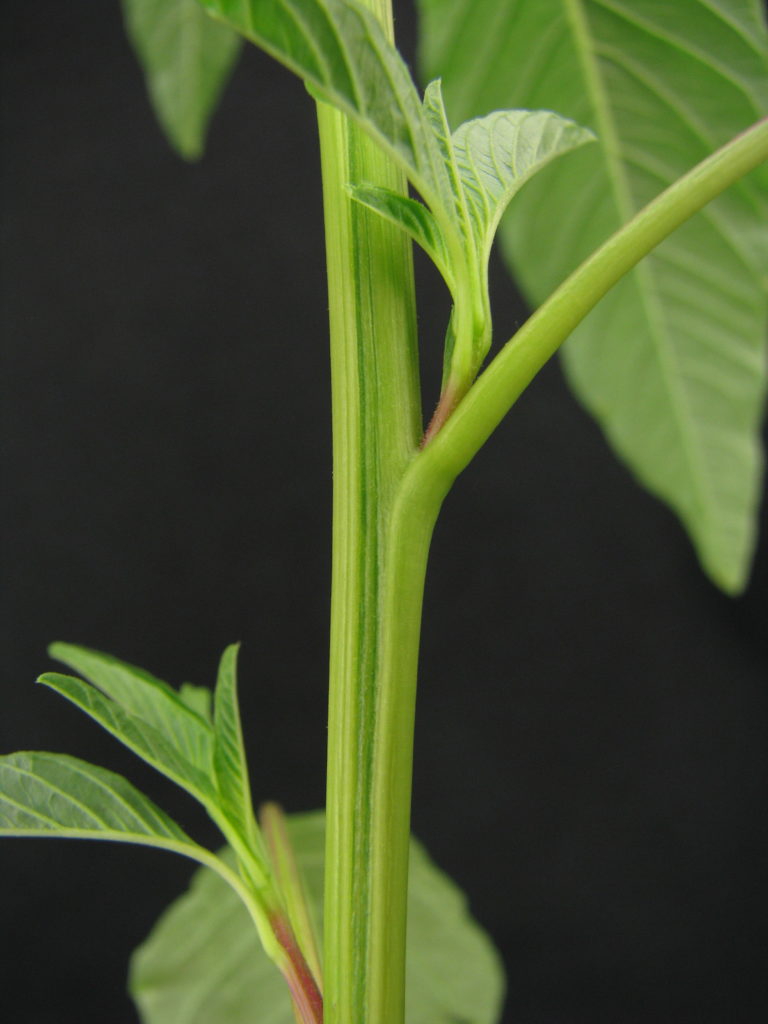
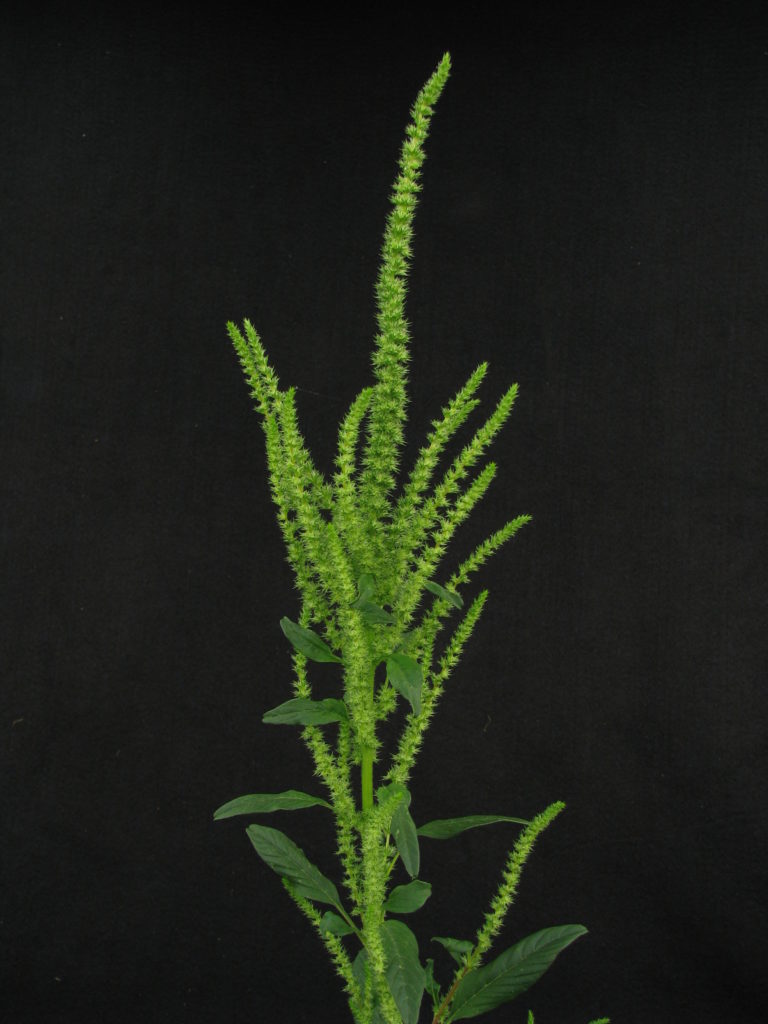
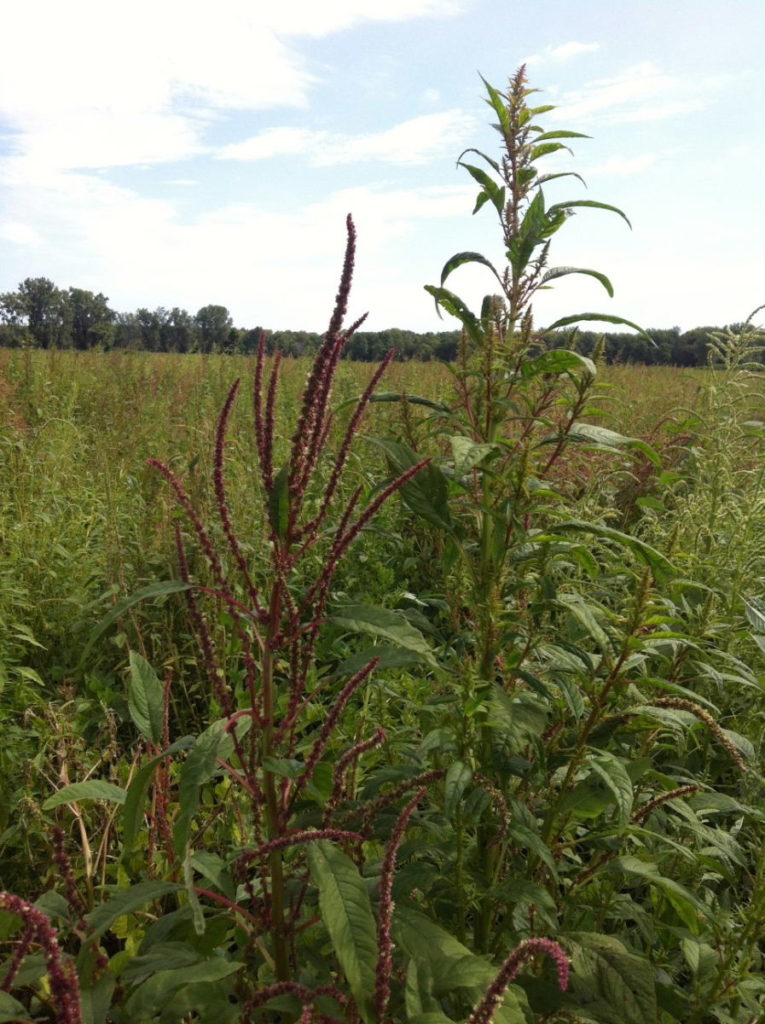

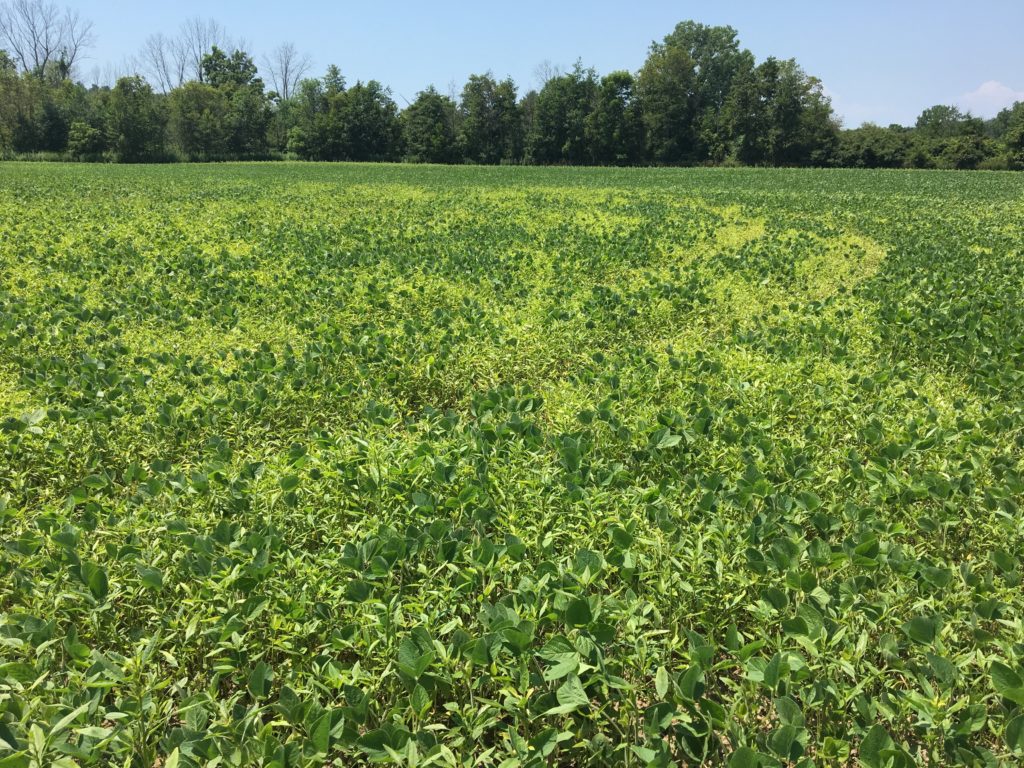
Ontario Counties with herbicide resistant waterhemp
A total of 195 waterhemp populations have been tested since 2002. Over 90% of populations are resistant to one or more of the following herbicide groups: WSSA groups 2, 5, 9, 14 and 27. The majority of populations are resistant to 2 or more different modes of action, with resistance to as many as 5 modes of action occurring.
The following image provides an overview of the number of waterhemp populations by county or district and the number of modes of action that they are resistant to.
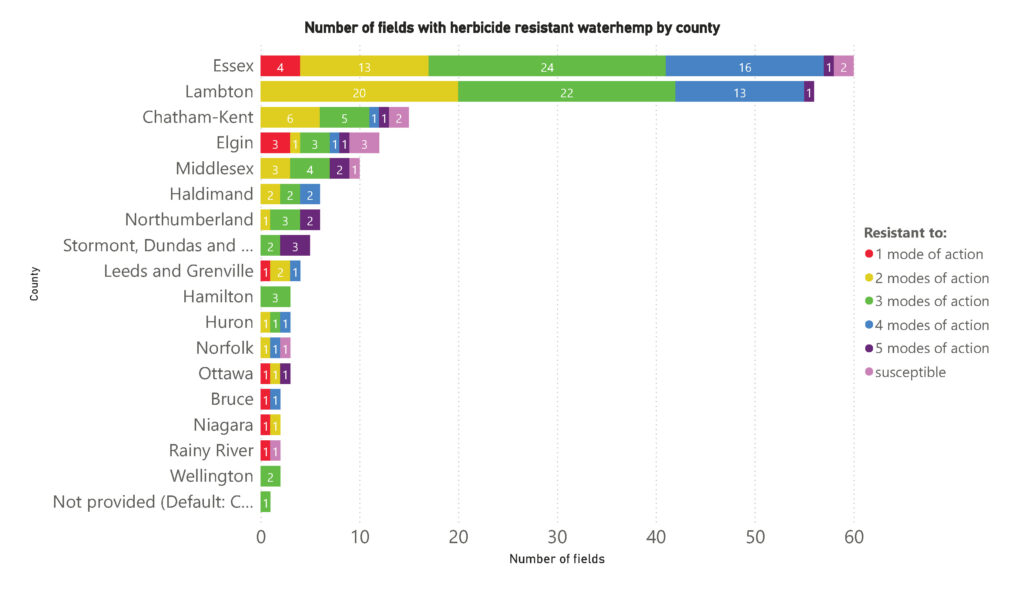
The image below provides a broad overview of where herbicide resistant waterhemp has been found in the province.

Go back to main index
Testing services to identify waterhemp and determine if herbicide resistant
There are two testing solutions available in Ontario. The plant bioassay service offered by the Tardif lab at the University of Guelph requires that mature seed is collected in the fall and submitted. Plants are then grown from that seed and sprayed at various doses of the herbicide(s) suspected. Results are provided typically by March, the service is provided at no cost to Ontario farmers. The molecular testing service, requires plant tissue that is roughly “loonie sized”, so a single leaf is often adequate. Results can be obtained in a matter of days, but it is a fee based service.
- Free plant bioassay testing by the University of Guelph
- Fee based molecular testing by TurnKey Genomics (private lab)
A harmonized monitoring protocol for waterhemp has been developed to enable coordination and information-sharing across provinces. This collaboration will contribute to knowledge of the distribution of herbicide-resistant populations of waterhemp in Canada, which will help inform management programs for this problem weed to limit its impact and further spread in Canada.
CONTROL IN CORN
Control of waterhemp is best achieved with a two-pass herbicide program where the first pass is with a pre-emergence (PRE) soil applied herbicide and the second with a postemergent (POST) herbicide. Consistency of waterhemp control with soil applied herbicides has varied and one should not expect perfect season long control. However, a soil applied herbicide will eliminate the majority of early seedlings and will reduce the risk of having large, less susceptible seedling plants emerged at the time of the post-emergence herbicide pass.
CORN: PREEMERGENCE HERBICIDES
| Herbicide | WSSA Group(s) | Control (%) | Corn Hybrid Trait |
| ACURON | 5,15,27,27 | 92 | All |
| INTEGRITY | 14,15 | 91 | All |
| CONVERGE XT | 5,27 | 89 | All |
| CALLISTO + AATREX | 5,27 | 86 | All |
| PRIMEXTRA II MAGNUM | 5,15 | 85 | All |
| ACURON FLEXI | 15,27,27 | 82 | All |
| HARNESS (acetochlor – not in Canada) | 15 | 82 | All |
| MARKSMAN | 4,5 | 79 | All |
| ZIDUA SC | 15 | 76 | All |
| ENGARDE | 2,27 | 73 | All |
| FRONTIER MAX | 15 | 72 | All |
| DUAL II MAGNUM | 15 | 69 | All |
| AATREX 480 | 5 | 61 | All |
| ENGENIA (dicamba) | 4 | 49 | All |
| BROADSTRIKE RC | 2 | 44 | All |

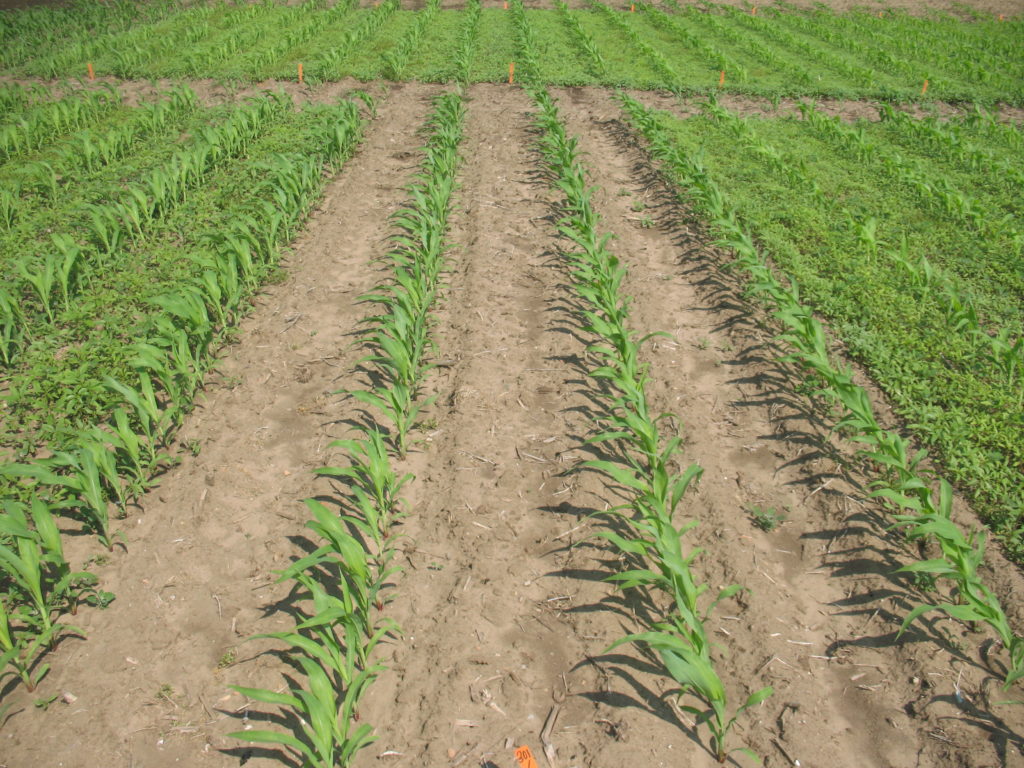
CORN: POSTEMERGENCE HERBICIDES
| Herbicide | WSSA Group(s) | Control (%) | Corn Hybrid Trait |
| ACURON | 5,15,27,27 | 96 | All |
| LAUDIS + AATREX 480 | 5,27 | 94 | All |
| ACURON FLEXI | 15,27,27 | 92 | All |
| SHIELDEX + AATREX 480 | 5,27 | 92 | All |
| CONVERGE XT | 5,27 | 92 | All |
| CALLISTO + AATREX 480 | 5,27 | 91 | All |
| HALEX GT + AATREX 480 | 5,9,15,27 | 89 | All |
| ENLIST DUO | 2,9 | 89 | E3 (Enlist) |
| ENGENIA (dicamba – high rate) | 4 | 84 | All |
| PRIMEXTRA II MAGNUM | 5,15 | 83 | All |
| ARMEZON + AATREX 480 | 5,27 | 82 | All |
| MARKSMAN | 4,5 | 81 | All |
| PARDNER + AATREX 480 | 5,6 | 80 | All |
| DESTRA IS | 2,27 | 78 | All |
| 2,4-D | 4 | 77 | All |
| ENGENIA (dicamba – low rate) | 4 | 71 | All |
| DISTINCT | 4,19 | 69 | All |
| LIBERTY 200 SN | 10 | 64 | E3 (Enlist), Liberty Link |
| VIOS G3 | 2,27 | 62 | All |
| AATREX 480 | 5 | 62 | All |
| PERMIT | 2 | 27 | All |
CONTROL IN SOYBEAN
Control of waterhemp is best achieved with a two-pass herbicide program where the first pass is with a pre-emergence (PRE) soil applied herbicide and the second with a postemergent (POST) herbicide.
SOYBEANS: PREEMERGENCE HERBICIDES
| Herbicide | WSSA Group(s) | Control (%) | Soybean Variety Trait |
| FIERCE | 14,15 | 90 | All |
| VALTERA | 14,15 | 83 | All |
| TRIACTOR | 2,5,14 | 82 | All |
| BIFECTA | 5,14 | 81 | All |
| AUTHORITY SUPREME | 14,15 | 80 | All |
| TAVIUM | 4,15 | 79 | RR 2Y Xtend |
| BOUNDARY LQD | 5,15 | 78 | All |
| CANOPY PRO | 2,5 | 76 | All |
| ZIDUA | 15 | 74 | All |
| DUAL II MAGNUM | 15 | 72 | All |
| INTEGRITY | 14,15 | 66 | All |
| FRONTIER | 15 | 65 | All |
| SENCOR | 5 | 60 | All |
| OPTILL | 2,14 | 56 | All |
| AUTHORITY | 14 | 55 | All |
| ERAGON LQ | 14 | 47 | All |
| ENGENIA (dicamba) | 4 | 43 | RR 2Y Xtend |
| FREESTYLE | 2,2 | 25 | All |
| PROWL H2O | 3 | 24 | All |
| PURSUIT | 2 | 17 | All |
| CLASSIC | 2 | 10 | All |
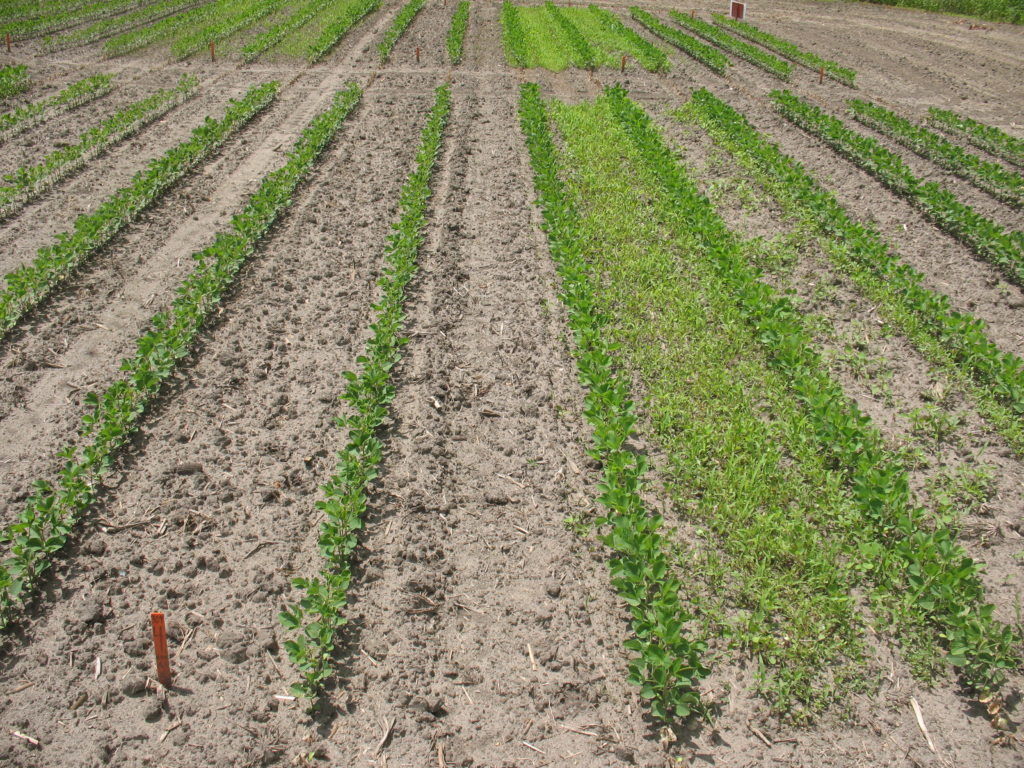
SOYBEANS: Postemergence herbicides
| Herbicide | WSSA Group(s) | Control (%) | Soybean Variety Trait |
| TAVIUM | 4,15 | 80 | RR 2Y Xtend |
| ENLIST DUO | 4,9 | 75 | E3 (Enlist) |
| ENGENIA (dicamba) | 4 | 74 | RR 2Y Xtend |
| HURRICANE | 6,14 | 62 | All |
| BLAZER | 14 | 59 | All |
| REFLEX | 14 | 56 | All |
| LIBERTY 200 SN | 10 | 45 | E3 (Enlist), Liberty Link |
| PINNACLE | 2 | 33 | All |
| CLASSIC | 2 | 26 | All |
| FIRSTRATE | 2 | 22 | All |
| CLEANSWEEP | 2,6 | 21 | All |
| BASAGRAN FORTE | 6 | 20 | All |
| PURSUIT | 2 | 5 | All |
CONTROL IN CEREALS
Overall, the experience in Ontario has been that winter cereals are a good rotational crop for reducing waterhemp populations. A limited amount of research has been completed in Ontario primarily because waterhemp has not been a problem in winter wheat thus far. This could be, in part, because the fall seeded winter wheat crop tends to out-compete spring emerging summer annuals like pigweed species which include waterhemp.

However, if waterhemp recruitment is a concern, Eragon LQ has been cited as being effective on waterhemp (Knezevic et al., 2010) and can be applied pre-plant to winter wheat. Otherwise, it would be logical to assume that cereal herbicides that are the most effective at controlling pigweed, would also be effective at controlling waterhemp should it show up in your winter wheat crop.
A trial evaluating winter wheat herbicides was conducted by the Tardif lab at the University of Guelph in 2023, results are provided in the following table. An interesting finding from this work is that the active ingredient fluroxypyr, which has been added to a number of herbicides to provide control of certain problem weeds (e.g. vetch) provides no activity on waterhemp.
WINTER WHEAT: Postemergence herbicides
| Herbicide | WSSA Group(s) | Control (%) |
| Buctril M | 6, 4 | 95 |
| Infinity | 27, 6 | 92 |
| MCPA Ester (high rate) | 4 | 85 |
| Estaprop XT | 4, 4 | 83 |
| 2,4-D Ester (high rate) | 4 | 77 |
| Lontrel XC | 4 | 50 |
| Fluroxypyr (e.g. found in Infinity FX, EnforcerM) | 4 | 0 |
INFLUENCE OF COVER CROPS
An Illinois study found that fall seeded cereal rye that was crimped prior to planting soybean consistently reduced biomass of waterhemp over a 3 year period compared to vetch or no cover crop (Davis, 2010). The main challenge with using cereal rye as a weed suppressing cover crop is that its thick residue can negatively affect soybean stand establishment which can result in variability of soybean yield as observed by Davis (2010) and Liebel et al., (1992). This should not be viewed as a deal breaker but rather the importance of residue management at the time of planting which has become easier with improvements in equipment units like strip tillers and row cleaners.
Go back to main index
INFLUENCE OF TILLAGE
Multiple studies have shown that waterhemp emergence is greater in no-till cropping systems compared to ones that include tillage (Refsell and Hartzler, 2009). An Iowa study demonstrated that duration of waterhemp emergence was 26 days longer in a no-till cropping system compared to one that used a chisel-plough (Refsell and Hartzler, 2009).
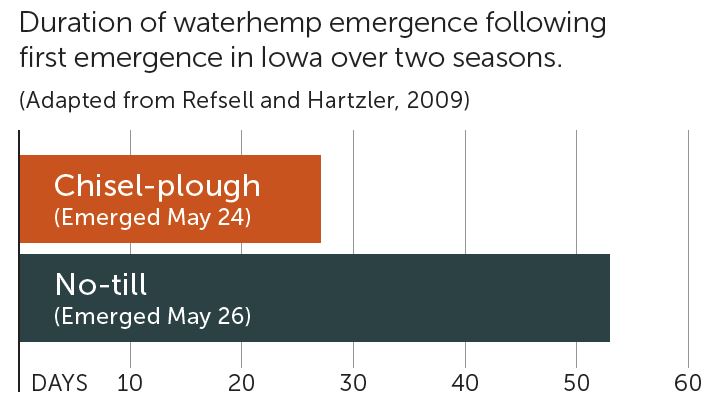
Go back to main index
Acknowledgments: Dr. François Tardif co-wrote the identification section and Dr. Peter Sikkema provided the herbicide efficacy data.
Further reading: Waterhemp was first identified in an Ontario field in 2003, when Dan Foster came upon some odd looking pigweed in a soybean field. You can read more about the “early days” of waterhemp in Ontario in this article.